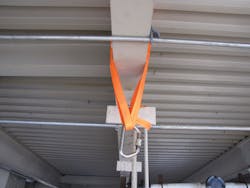Rope rescue techniques are the dominant skill set needed to effect a rescue in most technical rescue scenarios. As with any rope operation, organization of the rescue operation combined with rope proper systems will play a major role in a successful rescue. As with any rescue operations, proper planning and foresight throughout the operation will play a key role.
As with any operation a good size-up is needed. There are a lot of factors that will go into a confined space rescue size-up, but for purposes of this article we are going to focus on the rigging operation.
Confined spaces can be put into two categories:
- vertical - such as a storage tank
- horizontal - such as a large drainage pipe systems
Sometimes you will be faced with a rescue operation that encompasses both a horizontal and vertical space, such as a sewer system. It has a vertical entry point that transitions into a horizontal run. All confined spaces will present different and unique challenges however a solid skill set of rigging principals and the ability to adapt them to various spaces will allow you to perform these operations safely, efficiently, and effectively.
When performing a rigging size-up there are a few key things we're looking. One being anchor points and the second being the direction we want our rigging systems to travel. The anchor is going to be the most important aspect of your operation. Without it your rigging is useless. Bombproof anchors are our first choice but in the event bombproof is not a possibility thoroughly inspect your questionable anchor and be sure to back it up with an anchor of equal or greater size and strength.
The direction our rigging systems will travel ideally should always be in a straight line. In the event a straight line is just not possible simply utilize directional pulleys to redirect your system in the desired location. In other words, before you jump the gun and move your anchor point, steer your system with directional pulleys to its desired location. As with any system, changes in direction will create inefficiency's do to friction created by the bends in the rope. However the bigger picture, that being the victim, takes precedence. The minor friction loss you'll inherit by using directionals will in no way compromise your operation.
Rigging Techniques
Let's take some time now to look at rigging techniques for these operations.
Let's first look at vertical rescue operations. All vertical operations will need to utilize an overhead anchor preferably directly in-line with the entry hatch. These overhead anchors can be attained several ways. The first being an I-beam. If you look at Figures 1 and 2 you will see a single point anchor system as well as a load sharing anchoring anchor system. Both were created by using an I-beam(s) as the anchor point. Rope, webbing, or anchor straps will all do the trick. Just remember when utilizing a load sharing anchor system be sure to keep the angle created in the neighborhood of 45 to 60 degrees.
We can also use what's called a beam clamp, a device that clamps onto an I-beam creating a point to anchor from. This application would be beneficial when the I-beam sits flush against the roof decking or provides little space to pass rope, webbing, or an anchor strap through.
The last means of overhead anchoring that we will examine is a tripod (see Figure 3.) A tripod is what can be considered a mobile overhead anchor. This is based on the fact that it can be easily moved from one location to another. There are however some limitations. The tripod needs a surface over the entry point to stabilize it's legs on. It is versatile in the sense that the legs can be at different heights and still maintain a level overhead anchor point.
When utilizing a tripod as an overhead anchor you must keep the force from your system to generate inside the footprint of the tripod (see Figure 4.) When a pulling force is applied outside the footprint you run the risk of pulling the tripod over. You may be saying "the feet of the tripod should be secured to eliminate any vertical or horizontal movement!" and your right. However by pulling and creating a force load outside the footprint your going to introduce unwanted stress to the legs of the tripod. By using some simple rigging solutions, such as a Halligan or tieing off to the manhole steps, (see Figures 5 and 6) you can always keep your forces where their supposed to be.
Now let's focus on the rigging operation below the anchor. Overall this rigging operation should be kept simple, efficient and effective.(SEE.) Let's ask ourselves "what do we need?" The answer is simple. We need a means to get the rescuers up and down. We also need a belay system to protect the rescuers and the victim in the event there is a main line failure.
The up and down or vertical movement can be done two ways. Our choice of haul system's will be 4:1 mechanical advantage system (MAS) or a 5:1 MAS (see Figure 7). Utilizing a MAS to lower your rescuers can become very beneficial in the event a problem arises and a rapid exit of the confined space is necessary. Keep in mind however whatever the depth of your confined space is multiply that by five. That will give you enough rope if need be to haul from the outside of the tank, bottom location. a confined space that is 15 feet in depth will need ideally 75 feet of rope.
Another means of vertical movement is lowering the rescuer by means of a break bar rack. The only drawback to this is it only provides one direction of travel, down. If we decide to use this method we must have a haul system built and ready to be "piggybacked" onto the lowering line allowing us to bring the rescuer(s) back to the surface (see Figure 8.) I like to place this line (vertical movement) in the center of the rigging plate and expand left and right as we progress.
Preparing Belay Systems
The next portion of the rigging operation that we will cover is the belay system. Our rigging will be set up to supply four rescuers with belays. We do this because, in the event we need to perform a rapid intervention operation, there is no lost time rigging for our back-up team. Remember two in/two out.
Something I highly recommend and see infrequently is to utilize a separate anchor attachment point for your belays. Why? The answer is simple. If you rigged both your belays on your tripod and it failed or tipped over due to a sudden impact load all your belays would be lost. By utilizing separate anchor attachment points we can keep the belays totally independent and still effective in the event there is a failure or toppling of the tripod. It takes a little more work during initial rigging but it's well worth it.
These belay lines will be attached to the rescuers dorsal or back attachment point located on their harness and will remain there throughout the operation. The only rope that gets removed is the lowering line which is connected to the front connection point of the rescuers harness. Furthermore the only reason we remove that rope is if a second rescuer needs to be lowered into the space. If the size of the space will not support two rescuers, there is no need to remove any line.
System Placement
Now that we've covered a basic overhead rigging concept let's discuss placement of the systems. There is no need to overcrowd the entrance to the confined space with an over abundance of ropes and equipment. If you're utilizing a 4:1 MAS as your raise and lower system that should be the only rigging system where the control point is located directly over the entrance point of your confined space. Your belay systems should be redirected using directional pulleys to a control point away from the entrance point. If your means of lowering the rescuer is a break bar rack that too should then have a control point away from the entrance. By bringing your systems back away from the entrance point it allows you to better organize your rope operation and eliminates system confusion.
Now that we've tackled the rigging portion let's quickly touch on the placement of supplied air lines and any communication cables. A great spot for these items is on the open connection points left on your tripod. You can utilize kootney (knot passing pulleys) to guide the air and communication lines in and out of the confined space. A nice trick to keep these items away from the hole is to lightly secure them to one of the tripod legs by means of a prusick cord or piece of one-inch webbing.
The more you train on rigging configurations for confined space operations the more tricks you'll pick up. The bottom line however should be to keep your systems simple and well organized and that principle begins the moment you tie your first knot.
Stay safe and stay progressive.
MICHAEL R. DONAHUE is a 13-year veteran of the fire service is assigned to Rescue Company 1 in Elizabeth, NJ. Mike is the owner and founder of Progressive Rescue, a company dedicated to further firefighter's in all aspect of the job. He holds the title of rescue specialist with New Jersey's Urban Search and Rescue Team (NJ-TF1) and he is actively teaching at Middlesex and Somerset fire academies and the Middlesex County College as their Fire Science Program Coordinator.
About the Author

Michael Donahue
Owner and founder of Progressive Rescue, Mike Donahue is a 13-year veteran to the fire service. In those thirteen years Mike has experience as both a volunteer and federal firefighter and has been a career firefighter in the City of Elizabeth for the last 10 years, the last seven of which and currently working out of Rescue Company 1. Mike holds the title of Rescue Specialist with New Jersey's urban search and rescue team (NJ-TF1). You can find Mike actively teaching at Middlesex and Somerset Fire Academies as well as Middlesex County College as an Adjunct Professor and the Fire Science Program coordinator. He is actively involved in writing new course programs for the various organizations he teaches for. Mike has reviewed several text books for publishers such as Delmar and Jones & Bartlett. Mike has also co-written the new rope program for Jones & Bartlett and taught Rope Rescue Made Simple at Firehouse Expo 2010. Mike also is a monthly columnist for Firehouse.com covering the area of technical rescue. His teaching techniques and cutting edge style have gained the respect from many of his peers. Mike's passion, experience and desire to educate emergency service providers prove to be the driving force that has made him so successful. Progressive Rescue prides itself on providing the most cutting edge, diverse instructional programs available. We strive to provide your department with the most comprehensive, dynamic learning experience available at a truly competitive price. You can reach Mike by e-mail at [email protected]
